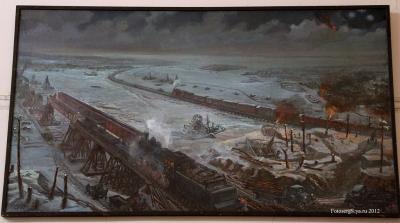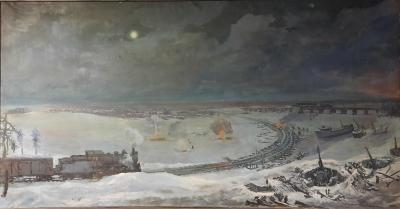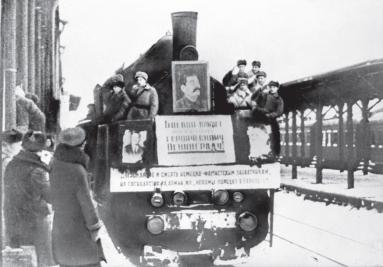On February 7, 1943 the steam engine #Eu708-64 crewed by the driver I. Pirozhenko, driver's assistant V. Dyatlev and stoker I. Antonov delivered the first train to Leningrad after the breakthrough of the siege. This trip was unique in its extreme riskiness as the crew literally ventured into the unknown. Railroad tracks were often laid without proper foundation upon compacted snow while part of the route passed within the distance of only 4 kilometers from the frontline and 6-7 kilometers from German artillery positions. After yielding a tiny 16 km long and 8 km wide corridor south of the Ladoga lake in January 1943, the Germans retreated to the commanding Sinyavino Heights which offered an excellent view of the area. The corridor passed through peat bog lowlands often below the sea level, while the steep hills from which German artillery observers sighted Soviet railroad construction and train movement rose to the height of up to 50 meters. Despite the frequent and accurate shellings, the 34 kilometer long railroad was built in only 2 weeks by both Red Army soldiers and the women of Leningrad who were mobilised for this task.
One of the most dangerous parts of this route was the low 1 300 meter long pile-based bridge across the Neva river which started at the southern outskirts of Shlisselburg and reached the other bank near the village Sheremetevka. Long wooden piles were driven into the river bed, holding the train along the vertical axis, while the ice around them prevented them from moving sideways. On February 5 all work on the new railroad line were completed and the first trial train with tanks from Leningrad drove across the bridge. On the next day the first train to Leningrad started from the station Volkhovstroy, carrying a cargo of 800 tons of butter for hospitals and orphanages. In the night from February 6 to February 7 it safely crossed the corridor and the freshly completed bridge without incidents, and in the morning the train crew was solemnly met in Leningrad. A big crowd gathered at the Finlandsky Train Station, and exactly at 10.09 the steam engine cut a red tape to the loud music of a brass band.
The "Road of Victory", as this railroad was officially dubbed, was extremely dangerous, and throughout the time of its operation several hundred people were killed or wounded, it played a major role in the battle of Leningrad. The city started receiving incomparably more cargo than it did earlier across the Ladoga lake, its industry started getting revived and food rationing norms became equal to those effective for the rest of the country. On this day the scales of the confrontation which lasted for an year and a half around the city and claimed the lives of nearly a million civilians tipped decisively in the favour of Leningrad, its soldiers and its long-suffering residents.




